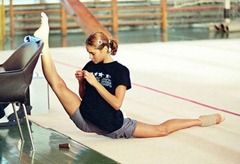Principles of Skeletal Muscle Adaptations
Posted on January 11th, 2012 by Andries

Some questions and answers on the principles of skeletal muscle adaptations during training and exercise.
- Analyze the influences on muscle fiber type with reference to genetics and training.
- Sports do not influence average muscle fiber type; athletes excel at different activities because of their muscle fiber types
- Genetics influences muscle fiber type
- Training influences muscle biochemistry
- Myosin isotomes do not change due to training, its genetically determined
- Endurance athletes cannot become a sprinter and vice versa
- Intermediate transitions can happen, IIa to IIa and vice versa
- Does endurance training cause adaptations in muscle structure?
- Doesn’t effect cross-sectional area of muscle or muscle fibers
- Adaptations include increased mitochondria proteins and increased glycolytic enzymes, therefore 2 X increase oxidative metabolism
- Intensity and duration of training affects degree of adaptations
- Degree of involvement of motor unit in person’s training affects adaptation
- Does resistance training show specific adaptations in fiber-type?
- Yes, repressed fastest MHC’s (myosin heavy chains) and increased expression of intermediate MHC’s
- Resistance training makes cross-bridges cycle at a slower rate and therefore maintaining force of contraction
- Resistance training decreases endurance capacity
- Both training forms increases strength and endurance when trained concurrently
- Does a decrease in physical activity change muscle structure?
- Large reduction in usage of motor units or decrease load against motor units contractions
- Decrease muscle and muscle fiber cross-sectional area
- Decreased in metabolic proteins that support endurance performance
- Marked atrophy from loss of myosin from myofibril pool
- Decrease in specific tension because decrease ability of atrophied muscles to make cross-bridges
- How does gender affect skeletal muscle differences?
- Men have greater muscle mass and muscle cross-sectional area
- Men have greater max force and max power capabilities
- Endocrine differences between gender is reason for muscle differences
- Cultural component as woman are often denied same level of physical activity as men
- Most of the differences are accounted to because of differences in muscle mass between genders
Tweet